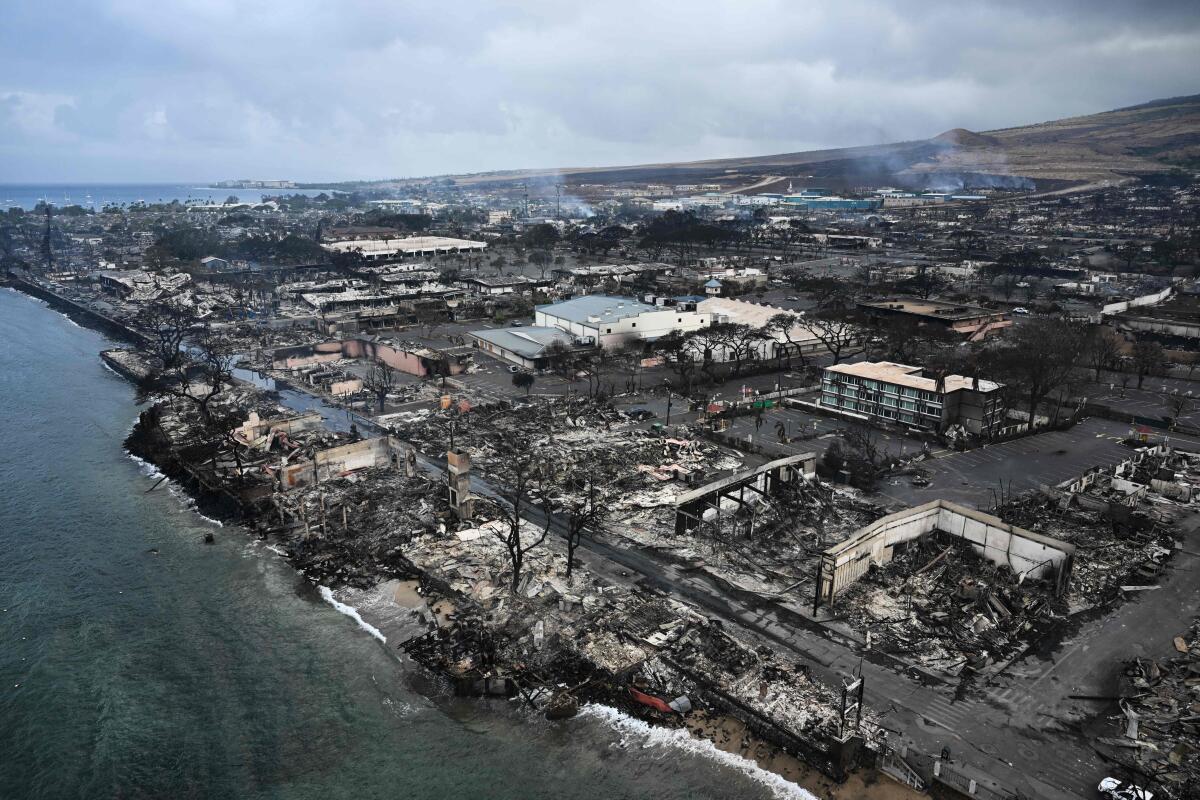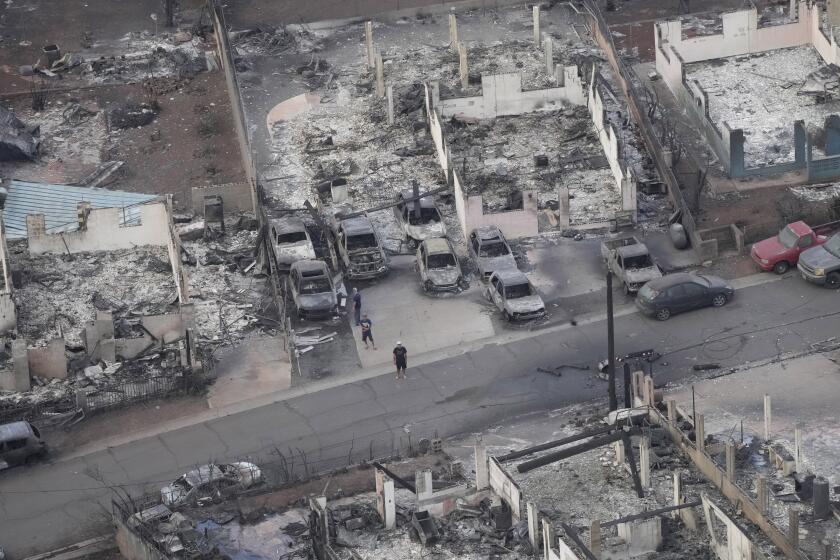AI, robots and satellite sensors are helping in the fight against wildfires

- Share via
This year has been a challenging one for Phil Schneider, who hasn’t seen wildfire behavior like this in his 47-year firefighting career.
Blazes raged through more than 2,000 acres of wildland in recent months in his county deep in the woods of Oregon, where a wet climate once made forest fires unthinkable. That’s an increasingly common scene around the world — from Canada to Greece, global warming has helped fuel larger and more destructive blazes, pushing firefighting services to the brink. But Schneider has a new recruit to help manage the growing risks: artificial intelligence.
“It’s a huge game changer for the fire service,” said Schneider of the technology created by Pano AI, which acts as a second set of eyes looking out for fires. While AI alone won’t completely ease the burden of wildfire management, it’s one of a growing number of tools firefighters have at their disposal to detect and combat blazes.
The high-tech fire lookout Schneider has recently put to work leverages panoramic cameras that capture minute-by-minute snapshots of their surroundings. Those images are then analyzed by an AI algorithm that has learned how to look for signs of fires. It’s a job that traditionally has been done by human eyes, whether it’s bystanders phoning in a fire or lookouts posted in towers.
It can take hours, if not days, to detect flames with conventional methods, said Schneider, a fire chief in Clackamas County. The AI system, on the other hand, can pick up the threat right away.
Wildfires on the Hawaiian island of Maui have killed at least 36 people, displaced thousands of residents and destroyed hundreds of structures, including homes, businesses and a school, prompting President Biden to declare a “major disaster.”
“Fires are burning hotter and faster. That early detection is going to make a difference,” Schneider said.
On one occasion, Pano’s AI fire watcher located a blaze that Schneider’s crew failed to find after an hours-long search in forests. In another case, it spotted a blaze 30 minutes before anyone else.
San Francisco-based Pano AI, which has built about 100 AI-enabled fire lookouts in six U.S. states and Australia, is one of a growing number of startups leveraging technology to aid in wildfire detection and prevention. Virtually nonexistent five years ago, the club of wildfire tech companies now has at least 400 members, said Bill Clerico, founder and managing director of Convective Capital, a venture capital firm focused on investing in the sector.
As the number of startups has grown, so too has the variety of offerings. Engineers in Germany enlist satellites and thermal imaging sensors to hunt down wildfires from the sky. In France, robots work side by side with human firefighters to combat blazes. And at Schneider’s fire department in Oregon, drones equipped with infrared cameras take off at night, helping firefighters map out burning sites in the dark.
“Technology could play a big role [in wildfire management],” Clerico said. “The demand is fueled by the problem, and the problem unfortunately is at historically bad levels.”
Indeed, wildfires have cost Europe an estimated $4.43 billion so far this year, fueled by extreme heat that has seared the Mediterranean from Greece to Spain. On the Hawaiian island of Maui, nearly 100 died in a firestorm that engulfed the town of Lahaina last month. And while the economic and human toll has been lower, Canada has seen a record swath of forest burn, releasing as much carbon dioxide as Mexico emits in a year.
ChatGPT and other new AI services benefit from a science fiction-infused marketing frenzy unlike anything in recent memory. There’s more to fear here than killer robots.
The problem is expected to get worse as climate change causes temperatures to rise and drought to become more frequent. An analysis, co-authored by the United Nations in 2022, warned that the global risk of cataclysmic wildfires will increase as much as 57% by the end of the century. In addition to climate change upping the risks, human infrastructure is as well, particularly power lines.
U.S. states such as California and Oregon are requiring electric utility companies to brace for the looming threat. Portland General Electric, which powers about half of Oregon’s homes, has budgeted nearly $51 million for wildfire preparation this year. Part of that was spent on Pano’s fire detection intelligence.
For a fee, Pano allows companies such as PGE to access information gathered by its fire lookout stations, not unlike how telecom network operators sell their service to mobile users. Since Pano’s algorithm has yet to master distinguishing smoke from dust and fog, human fire watchers are assigned to verify every AI-generated alert before sending it out. The startup says that approach boosts accuracy to “almost 100%.”
That has spared PGE staff from having to exhaustively look out for blazes 24 hours a day in a service area equivalent to about 3,000 Central Parks, according to Dan Nuñez, who manages the utility’s wildfire planning and analytics. Pano’s digital firewatcher has also spotted smoke that a human spotter would struggle to see, Nuñez said: “The AI just does such a better job.”
Those words are music to the ears of Sonia Kastner, who has seen “surging” demand since she co-founded Pano. The startup this year has sold its subscription-based fire detection service to more than two dozen customers, up from four clients in 2021 when Pano first introduced the service. The company’s monitoring network currently covers nearly 9 million acres of wildland — an area larger than Hawaii — but it’s a fraction of the wildfire-prone areas around the world.
Other companies, such as OroraTech in Munich, Germany, are offering a bigger-picture way to spot fires: looking for them from space.
OroraTech uses infrared imaging sensors installed on more than 20 satellites to detect fires worldwide. As the satellites are orbiting the Earth, the sensors pick up signs of fire — as small as roughly half of a tennis court — and provide several updates an hour to users, said Axel Roenneke, chief commercial officer of the company.
While satellites have been used to look for wildfires for decades — NASA’s Landsat satellites have been collecting information about wildfires since the 1970s — Roenneke said OroraTech’s infrared imaging solution enables firefighters to see through forest canopy or trace the progress of a fire even through thick smoke, providing intelligence that conventional visual sensors can’t offer.
Its satellite-based early detection, combined with AI-empowered analytical tools, has earned OroraTech more than $3 million in revenue this year from 30-plus customers, Roenneke said. The startup expects its sales to grow fivefold in 2024.
Early detection is just one component of wildfire management. Once a fire is identified, it generally has to be put out, particularly if it poses a threat to infrastructure or nearby communities. But combating fire is a risky profession. In 2021 alone, the U.S. lost 10 firefighters to dangerous blazes in forests. Two firefighters in Canada were killed during this year’s unprecedented wildfire season.
To reduce the risk to human firefighters, French startup Shark Robotics builds robots that can be sent to the front lines.
Connected via radio signals, human firefighters can operate Shark’s robot from up to 0.6 miles away, watching the flames using the robot’s thermal camera and using water to battle the blaze, said Cyrille Kabbara, the startup’s founder. Since the debut of Shark’s first product in 2017, more than 300 robotic firefighters have been put in service in 15 markets, including France, India and Switzerland, Kabbara said.
One barrier to wider adoption of wildfire technologies is skepticism. Solutions such as firefighting robots and AI detectors are useful only if firefighters use them, but convincing fire authorities isn’t an easy task. “We can’t scale this by just selling to progressive cities and counties,” Kastner said.
Many wildfire solution startups also face technological limitations. Take early fire detection. While AI cameras can provide real-time feeds, their detection power weakens at night. Satellite-based thermal sensors can see through the darkness, but their images often come with a delay.
“There is no one solution that is going to fix everything,” said Ankita Mohapatra, an associate professor at Cal State Fullerton who is creating a smart sensor that can be mounted on trees to detect forest fires. The future of battling blazes, according to Mohapatra, will rely on human firefighters utilizing multiple high-tech solutions.
But who will pay for those solutions remains a troublesome question. Pano said its customers typically pay $50,000 per year to gain access to one fire lookout station. Deep-pocketed companies such as PGE can afford it, but local fire chiefs such as Schneider cannot.
If PGE didn’t sponsor its access to Pano’s AI cameras, it would be “very hard” to afford the service, Schneider said.
In July, the Biden administration provided $185 million in additional funding to help wildland firefighters prepare for and respond to wildfires, following an already allocated fire management budget of $278 million in fiscal year 2023. While it is unclear if, or what portion of, the fresh funding will be spent on tech-based solutions, Schneider said a high-tech-aided future will eventually arrive for him and his fellow firefighters.
“Technologies will keep rolling in,” Schneider said. “Using extra tools to our advantage just helps us do our job.”
More to Read
Inside the business of entertainment
The Wide Shot brings you news, analysis and insights on everything from streaming wars to production — and what it all means for the future.
You may occasionally receive promotional content from the Los Angeles Times.












